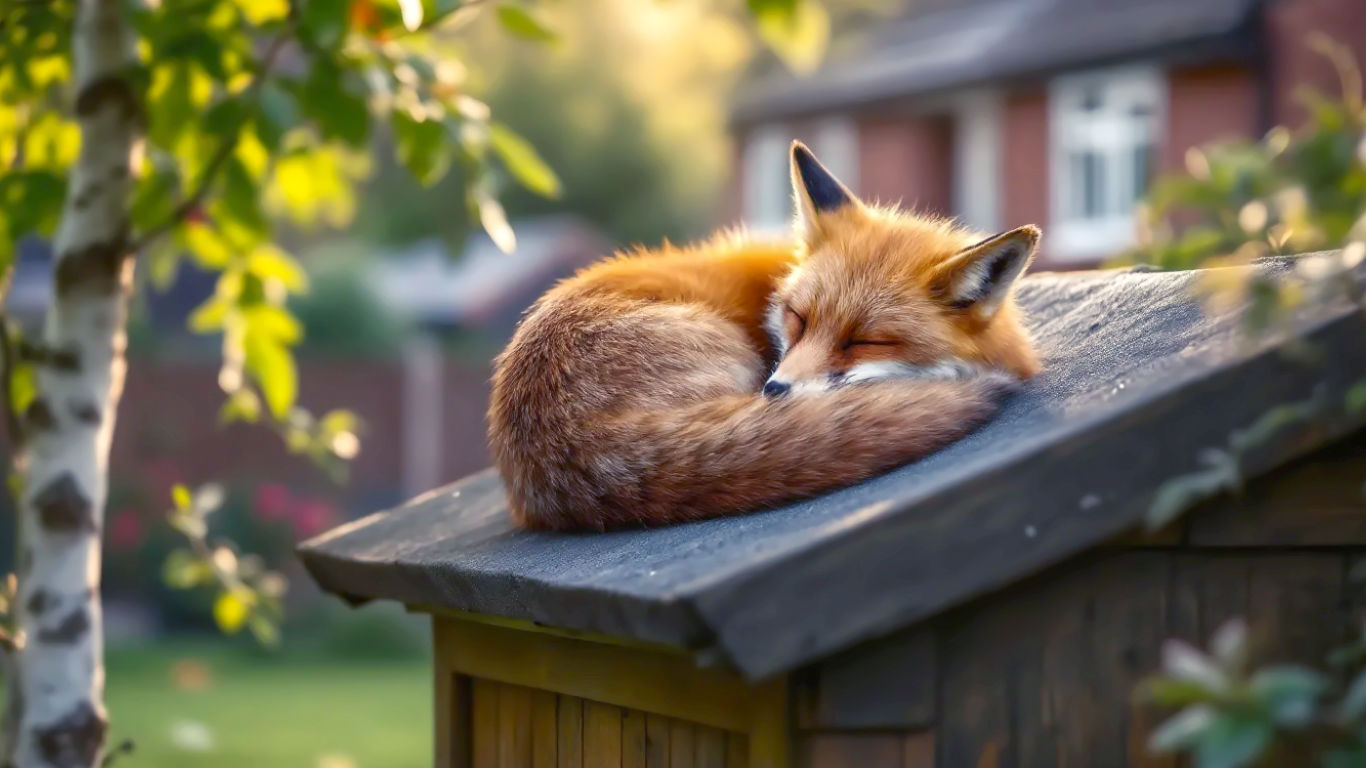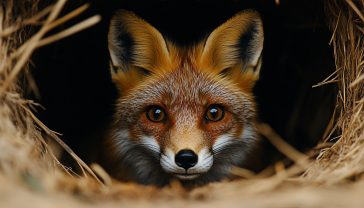Where Do Foxes Sleep? The Secret Nooks and Hidden Homes of Britain’s Most Cunning Neighbour
Ever wondered where foxes go to sleep? This ultimate guide explores the hidden world of fox dens, earths, and their secret daytime resting spots in the UK.

This post may contain affiliate links. If you make a purchase through these links, we may earn a commission at no additional cost to you.
Spend any time in Britain, whether in the rolling hills of the Cotswolds or a quiet London suburb, and you’ll likely have a brush with the red fox. A flash of a bushy tail, a pair of amber eyes glinting in the dark—these creatures are woven into the very fabric of our landscape. We see them trotting boldly down city streets after dark or hear their strange, chilling cries on a winter’s night. But for all their visibility, a fundamental part of their lives remains a mystery to most of us: where do they go when the world wakes up? Where do foxes sleep?
The answer isn’t as simple as pointing to a single type of home. Foxes are masters of adaptation, resourceful survivors who have learned to thrive everywhere from the wild Scottish Highlands to the manicured gardens of Kent. Their sleeping arrangements are just as clever and varied as they are. They aren’t just animals who dig a hole and call it a day; they are strategic architects, shrewd opportunists, and loving parents whose homes—or ‘dens’—are central to their survival.
Understanding where a fox lays its head is more than just a piece of wildlife trivia. It’s a window into their secret world. It tells us about their family lives, their struggles, and their incredible ability to make a home for themselves right under our noses. From deep, earthy tunnels dug into a farmer’s field to a cosy nap under a garden shed, we’re about to uncover the hidden habits of one of Britain’s most iconic and misunderstood animals. So, let’s pull back the curtain on the private life of the red fox and discover where they truly rest.
The Fox’s Home: More Than Just a Hole in the Ground
When we think of a fox’s home, the word that usually springs to mind is a ‘den’ or an ‘earth’. These terms are often used interchangeably, and both describe the underground burrow systems that foxes use for shelter, safety, and raising their young. But calling it just a hole in the ground doesn’t quite do it justice. A fox earth is a carefully selected and often meticulously maintained sanctuary, vital for their survival.
Foxes don’t just start digging anywhere. They are incredibly picky about location, and for good reason. A good den needs to be safe from predators, sheltered from the unpredictable British weather, and close to reliable food and water sources.
What Makes the Perfect Spot?
Imagine you’re a fox looking for a place to set up home. What’s on your checklist?
- Good Drainage: No one likes a soggy home. Foxes instinctively choose well-drained soil, often on a slope or bank. Sandy or light loamy soils are ideal because they are easy to dig and don’t get waterlogged after a heavy downpour. This is why you’ll often find fox earths on the sides of hills, railway embankments, or in hedgerows.
- Cover and Concealment: Foxes are naturally cautious creatures. They want their front door to be hidden from prying eyes. Dense vegetation like bramble patches, thickets of gorse, or the base of a large tree provides the perfect camouflage. The entrance is often obscured by overgrown roots or bushes, making it incredibly difficult to spot unless you know exactly what you’re looking for.
- A Room with a View (and an Escape Route): Safety is paramount. A den on a slight incline gives the fox a good vantage point to spot danger approaching. More importantly, a well-established earth will almost always have multiple entrance and exit holes. This isn’t just for convenience; it’s a critical security feature. If a badger, dog, or human threatens one entrance, the fox family has a network of escape tunnels to slip away unnoticed. Some of these holes might be tiny, barely visible bolt-holes used only in an emergency.
- Sunny Aspect: Especially during spring when cubs are young, a south-facing bank is highly prized. The warmth of the sun helps keep the den dry and provides a comfortable spot for the cubs to bask and play near the entrance without getting too cold.
Foxes are also great opportunists. While they are perfectly capable of digging their own dens from scratch, they’re not ones to turn down a ready-made home. They will happily move into abandoned badger setts or rabbit warrens, often enlarging the tunnels to suit their needs. A badger sett is a particularly attractive option, as the heavy lifting has already been done by a master digger. Sometimes, foxes and badgers even share different parts of a large, complex sett at the same time, maintaining a sort of respectful distance like neighbours in a block of flats.
The Architecture of a Fox Earth: A Look Inside
A fox earth is more than just a single tunnel. A main breeding earth, used year after year, can be a complex and surprisingly sophisticated structure.
- The Main Entrance: This is usually the largest and most obvious hole, often around 25-30 cm in diameter. You can often spot signs of recent activity here: freshly dug soil fanned out in a delta shape, fox tracks in the mud, and sometimes the remains of a meal (like bird feathers or rabbit fur) scattered nearby. A distinct, musky smell is also a dead giveaway.
- Tunnels and Chambers: From the entrance, a tunnel slopes down into the earth. This isn’t just a straight pipe. It can twist and turn, sometimes for several metres. Along this main tunnel, or at its end, the fox will excavate one or more chambers. The main chamber is the nursery, where the vixen gives birth and the cubs spend their first few weeks. It’s typically about a metre or two underground, deep enough to be insulated from the cold and safe from being accidentally dug up by a passing threat. The chamber is just large enough for the vixen and her cubs to lie comfortably. Unlike badgers, foxes don’t bring in bedding like grass or leaves; they prefer to sleep on the bare earth.
- Escape Routes and Ventilation: Branching off the main tunnel are smaller passages leading to the emergency exits. These escape holes are often smaller and better hidden than the main entrance. This network of tunnels also provides crucial ventilation, keeping the air inside fresh.
The size and complexity of an earth can vary enormously. A young fox pair might dig a simple, short burrow for their first litter. But a prime location that has been used by generations of foxes can become a sprawling underground network, with dozens of holes and tunnels extending over a large area.
The Urban Fox: A Different Kind of Homeowner
Of course, not all British foxes live in idyllic countryside settings. A huge number of them are now city-dwellers, and their approach to housing has adapted accordingly. While the fundamental needs remain the same—safety, warmth, and shelter—the materials and locations are wildly different.
Urban foxes are the ultimate opportunists. They’ve learned that the human-built environment offers a wealth of five-star real estate, often with less digging required.
Prime Urban Real Estate
- Under the Garden Shed: This is the classic urban fox den. The space beneath a garden shed is a fox’s dream home. It’s dark, dry, and already has a solid roof. It’s sheltered from the elements and, crucially, from most human disturbance. To a vixen, a well-sited shed is a pre-made, fortified nursery. Many a British gardener has been surprised to discover a litter of cubs peering out from under their potting shed in spring.
- Decking and Patios: The void beneath raised decking is another prime spot. It offers the same benefits as a shed—shelter and security—and is often located conveniently close to a potential food source (such as leftover pet food or a poorly secured bin).
- Drainage Pipes and Culverts: Disused pipes and drainage systems provide ready-made tunnels. These are particularly popular as temporary shelters or places to lie up during the day, as they offer excellent cover.
- Allotments and Overgrown Gardens: These areas are a paradise for urban foxes. The combination of sheds, compost heaps (which generate warmth), and dense, untended vegetation provides a perfect habitat for both denning and foraging.
- Industrial Estates and Railway Embankments: These ‘edgelands’ of our cities are often less disturbed by people, especially at night. The scrubby land, man-made banks, and various structures offer countless opportunities for a fox to create a den, either by digging into the earth or occupying a space within a derelict building.
Urban foxes still dig, of course. They will happily excavate earths in parks, cemeteries, golf courses, and even large private gardens if the soil is suitable. But their willingness to adopt and adapt man-made structures is a key reason for their incredible success in our towns and cities. They see our world not as a concrete jungle, but as a landscape rich with housing opportunities.
A Bed for the Night: Where Foxes Sleep When Not in a Den
It’s a common misconception that foxes spend all their downtime tucked away in an underground earth. In reality, adult foxes, particularly outside the breeding season, often don’t sleep in a den at all.
Dens are primarily for one thing: raising a family. From late winter until the cubs are old enough to fend for themselves in early summer, the den is the centre of fox life. But for the rest of the year, most adult foxes prefer to sleep above ground. This might seem strange, but it makes perfect sense from a fox’s perspective. An underground den can be damp and is a hotspot for fleas and other parasites. Why stay there if you don’t have vulnerable cubs to protect?
So, where do they sleep instead? They choose safe, sheltered spots known as ‘lying-up’ sites or ‘couches’. These are temporary, above-ground beds where a fox can rest undisturbed during the day.
Choosing a Couch: The Fox’s Daytime Retreat
The criteria for a good lying-up spot are similar to those for a den: shelter and concealment are key.
- In the Countryside: A rural fox has plenty of options. They might choose:
- A dense thicket of brambles or gorse.
- A patch of thick bracken on a hillside.
- A sheltered spot at the base of a dry-stone wall or in a dense hedgerow.
- A dry ditch or a hollow under an old tree root.
- Even just curling up in a depression in a field of long grass on a sunny day.
- In the City: An urban fox finds its couches in our backyards and forgotten corners. Favourite spots include:
- On top of a garden shed roof: A flat shed roof, especially one warmed by the sun, offers a fantastic vantage point. From here, a fox can doze safely while keeping an eye and an ear out for any approaching danger.
- Under a trampoline: The space under a garden trampoline provides excellent cover from above.
- On a compost heap: A well-established compost heap generates a gentle warmth, making it a wonderfully cosy bed, especially on a cold day.
- In a greenhouse or polytunnel: These structures offer shelter from wind and rain.
- Tucked away under dense bushes: A thick cotoneaster or a sprawling laurel bush provides the perfect hidden spot for a daytime nap.
Foxes are creatures of habit. If a fox finds a particularly safe and comfortable lying-up spot, it will often return to it day after day. They may have several favourite spots within their territory that they use depending on the weather and wind direction.
When sleeping above ground, a fox typically curls up tightly, nose to tail. That magnificent bushy tail, or ‘brush’, isn’t just for show. In cold weather, the fox wraps it around itself like a scarf, tucking its nose and paws underneath to conserve body heat. Their hearing remains incredibly sharp even when they appear to be fast asleep, and the slightest unusual sound will have their head up and ears twitching in an instant.
The Seasonal Cycle: How Sleeping Habits Change Through the Year
A fox’s choice of bedroom is not static; it changes dramatically with the seasons, driven by the ancient rhythms of mating, birth, and raising young.
Autumn (September – November)
This is a time of dispersal and independence. The cubs from the previous spring are now fully grown and are leaving their parents’ territory to find their own. The family unit has broken down. The main breeding earth is largely abandoned for now, and adult foxes will almost exclusively sleep above ground in their chosen lying-up spots. They are focused on building up their fat reserves for the winter ahead.
Winter (December – February)
Winter is mating season. The nights are filled with the eerie, shrieking calls of vixens and the sharp barks of dog foxes. Foxes remain largely solitary or in pairs. They continue to sleep above ground, but will seek out more sheltered spots to protect themselves from the harsh weather—deep thickets, hollow logs, or under man-made structures.
As winter progresses, a mated vixen will begin to prepare for the arrival of her cubs. She will start investigating potential den sites, cleaning them out and re-digging tunnels. She may prepare several dens before settling on the one she feels is safest. This is known as the ‘natal den’ or ‘breeding earth’. The dog fox doesn’t sleep in the den with her, but he will stay nearby, often sleeping above ground close to the den entrance, guarding his family.
Spring (March – May)
This is the most important time of year for the fox den. In late March, the vixen gives birth to her litter of 4-5 cubs, deep inside the natal chamber. The cubs are born blind, deaf, and helpless, and for the first couple of weeks, the vixen barely leaves them. She stays with them underground, relying on the dog fox to bring her food. The den is a warm, dark, safe nursery.
By the time the cubs are about four weeks old (late April or early May), they will start to emerge from the den for the first time. This is a magical sight. They will stay very close to the entrance, playing, tumbling, and exploring their immediate surroundings under the watchful eye of the vixen. The area around the den entrance becomes a playground, and you can often see well-worn paths and flattened areas where the cubs have been active.
During this period, the vixen may move the litter to another den if she senses danger or if the first den becomes too infested with fleas. Fox families often have several dens within their territory, and they will move the cubs between them if disturbed.
Summer (June – August)
By early summer, the cubs are growing fast and are becoming much more adventurous. They are now spending more time above ground than in the den, learning to hunt and forage with their parents. The den is used less as a primary home and more as a safe base to retreat to if danger threatens. You might see the cubs sleeping outside the den during the day, basking in the sun.
As summer wears on, the family begins to break apart. The cubs are now nearly adult-sized and are becoming increasingly independent. By August, the den is usually abandoned completely. The year’s work is done, and the den will now lie empty until the cycle begins again the following winter. The whole family, adults included, will now be sleeping above ground in their various lying-up spots.
Myths and Misconceptions: Debunking Fox Sleeping Habits
The secret life of foxes has led to a lot of folklore and misunderstanding. Let’s clear a few things up.
- Myth: Foxes are dirty and their dens are filthy.
- Reality: While the area around a den with cubs can look messy due to scattered food remains, foxes are actually quite clean animals. They don’t defecate inside their dens and will often designate a specific ‘latrine’ area nearby. The musky smell associated with foxes comes from scent glands, not a lack of hygiene.
- Myth: All foxes live in dens all year round.
- Reality: As we’ve seen, this is untrue. Dens are primarily nurseries. For most of the year, adult foxes prefer the fresh air and will sleep in a variety of sheltered, above-ground locations.
- Myth: If I see a fox out during the day, it must be sick.
- Reality: This is one of the most persistent myths. It’s perfectly normal to see a fox during the day, especially in urban areas where they have become bolder. They might be moving between resting spots, looking for a snack, or simply enjoying a spot of sun. A sick fox will usually look visibly unwell—mangy, thin, and behaving erratically. A healthy fox trotting calmly across a park at lunchtime is usually nothing to worry about.
Living with Our Foxy Neighbours
For many people in Britain, a fox isn’t a distant wildlife documentary star; it’s a neighbour. Understanding their sleeping and denning habits is key to coexisting peacefully.
If you discover a fox has decided to make a den under your shed, the best advice is usually to leave it alone, especially if it’s between March and June. This is almost certainly a vixen with her cubs. They will cause very little harm, and attempting to block up the den at this time is not only cruel (as you could trap them inside) but also illegal. The family will naturally move on by mid-summer, at which point you can safely block the access point if you don’t want them returning next year.
Mostly, sharing your garden with a sleeping fox is a privilege. It’s a chance to observe a truly wild and incredibly intelligent animal up close. By understanding that the fox curled up on your shed roof is just looking for a safe, quiet place to rest, we can better appreciate our role as custodians of the urban and rural landscapes we share.
From the deepest, darkest earth dug into a quiet hillside to a sunny spot on a garage roof in suburbia, the sleeping places of the red fox tell a story of resilience, intelligence, and remarkable adaptability. They are a constant and welcome reminder that even in our modern, crowded island, wildness is never very far away. It’s sleeping just at the bottom of the garden.
Further Reading
For those interested in learning more about the fascinating lives of British foxes, these resources are an excellent starting point:
- The Wildlife Trusts: A nationwide network of trusts dedicated to conserving British wildlife. Their website has excellent fact files on foxes.
- The Fox Project: A charity dedicated to the welfare of the red fox, offering advice, rescue services, and a wealth of information.
- RSPCA (Royal Society for the Prevention of Cruelty to Animals): Provides guidance on living alongside urban foxes and what to do if you find an injured or sick fox.
- The Mammal Society: A charity advocating for science-led mammal conservation, with detailed information on British mammal species, including foxes.






